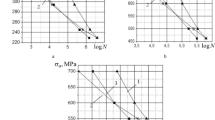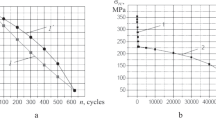Abstract
The application of the French lines to the prediction of high-cycle fatigue life according to the time of initiation of a macrocrack is justified. The French line is regarded as a line separating the regions of propagating and nonpropagating fatigue cracks. A method for the evaluation of the French line parameters in the region of low-cycle loading via the parameters of the Coffin-Manson diagram is proposed.
Similar content being viewed by others
REFERENCES
H. J. Grover, “An observation concerning the cycle ratio in cumulative damage,” in: Fatigue in Aircraft Structures, STR 274 (1960), pp. 120–124.
S. Ya. Yarema, “Stepwise character of fatigue fracture and its consequences,” Fiz.-Khim. Mekh. Mater., No. 6, 66–72 (1973).
V. I. Trufyakov (Ed.), Strength of Welded Joints under Variable Loads [in Russian], Naukova Dumka, Kiev (1990).
H. French, “Fatigue and hardening of steels,” Trans. ASTM, 21, 889–946 (1983).
P. Lukas and L. Kunz, “Vrubovy soucinitel ve vysokocyklove unave,” Trans. ASTM, 18, 591–601 (1980).
V. S. Ivanova and V. F. Terent’ev, Nature of Fatigue of Metals [in Russian], Metallurgiya, Moscow (1975).
J. A. Collins, Damage of Material in Structures. Analysis, Prediction, and Prevention [Russian translation], Mir, Moscow (1984).
V. P. Kogaev, N. A. Makhutov, and A. P. Gusenkov, Strength and Durability Analyses for Machine Parts and Structures. A Handbook [in Russian], Mashinostroenie, Moscow (1985).
M. M. Gokhberg, Metallic Structures of Hoisting and Transport Machines [in Russian], Mashinostroenie, Leningrad (1976).
V. T. Troshchenko, L. A. Khamaza, V. V. Pokrovskii, et al., Cyclic Strains and Fatigue of Metals [in Russian], Vol. 1: Low-and High-Cycle Fatigue of Metals, Vol. 2: Cyclic Strains and Fatigue of Metals, Naukova Dumka, Kiev (1985).
M. Kresnil, “The degree of damage at the French curve and at the fatigue limit during oscillating bend loading,” Met. Treat. Drop Forg., 32, 55–63 (1965).
V. V. Panasyuk, O. P. Ostash, and E. M. Kostyk, “Initiation of fatigue cracks near stress concentrators,” Fiz.-Khim. Mekh. Mater., No. 6, 3–10 (1985).
M. Kh. Blekhman and V. L. Indenbom, “Interaction of dislocations at small distances and crack initiation,” Fiz. Tverd. Tela, 16, No. 9, 2678–2688 (1974).
G. P. Karzov, B. Z. Margolin, and V. A. Shvetsova, Physicomechanical Simulation of Fracture Processes [in Russian], Politekhnika, St. Petersburg (1993).
V. M. Goritskii and V. F. Terent’ev, Structure and Fatigue Fracture of Metals [in Russian], Metallurgiya, Moscow (1980).
V. V. Panasyuk (Ed.), Fracture Mechanics and Strength of Materials [in Russian], A Handbook in 4 volumes, Vol. 4: O. N. Romaniv, S. Ya. Yarema, G. N. Nikiforchin, et al., Fatigue and Cyclic Crack Resistance of Structural Materials, Naukova Dumka, Kiev (1990).
H. Misawa and Y. Kawada, “The crack propagation by the stress amplitude below the fatigue limit,” Bull. JSME, 17, No.106, 434–441 (1974).
P. I. Kudryavtsev, Nonpropagating Fatigue Cracks [in Russian], Mashinostroenie, Moscow (1982).
K. J. Miller, Creep and Fracture, North Holland Publishing Company (1982).
V. S. Ivanova, Strength and Fracture of Metallic Materials [in Russian], Metallurgiya, Moscow (1992).
Author information
Authors and Affiliations
Additional information
Translated from Problemy Prochnosti, No. 1, pp. 88–95, January–February, 2005.
Rights and permissions
About this article
Cite this article
Manzhula, K.P. On application of the french lines for the prediction of the number of cycles to failure. Strength Mater 37, 64–69 (2005). https://doi.org/10.1007/s11223-005-0017-y
Received:
Issue Date:
DOI: https://doi.org/10.1007/s11223-005-0017-y




